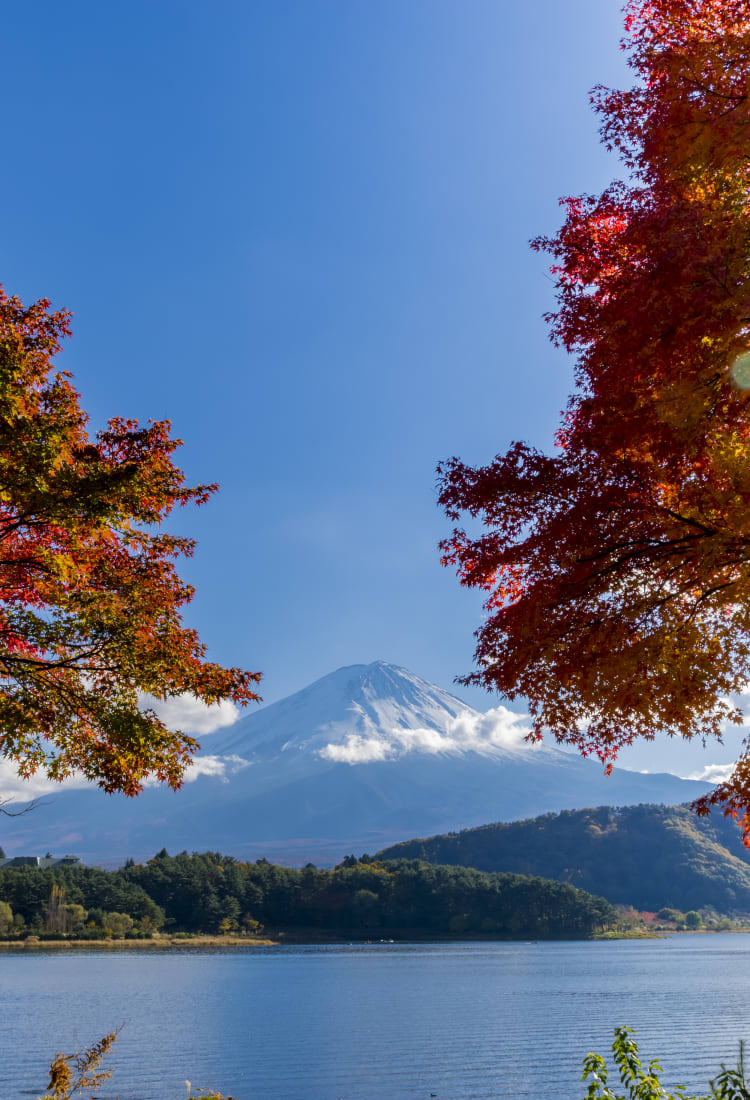

YAMANASHI Gebiet der fünf Fuji-Seen Endloser Freizeit- und Kulturgenuss an den fünf Seen des Berg Fuji
Endloser Freizeit- und Kulturgenuss an den fünf Seen des Berg Fuji
Die fünf Fuji-Seen – von den Einheimischen Fujigoko genannt – heißen Yamanakako, Kawaguchiko , Saiko, Shojiko und Motosuko. Diese malerischen Kraterseen bieten einige der besten Freizeitaktivitäten und Kulturveranstaltungen Japans – in einer Umgebung, die zu jeder Jahreszeit umwerfend ist.
Nicht verpassen
- Die unzähligen Wassersportmöglichkeiten
- Die unverbaute Sicht auf den Berg Fuji vom Motosuko-See aus
- Die farbigen Blätter an der Nordküste des Kawaguchiko-Sees Anfang November
Anfahrt
Von Tokyo nimmt man einen Schnellzug der JR Chuo Line und steigt am Bahnhof Otsuki in die Fuji Kyuko Line um (der JR-Eisenbahnpass gilt hier nicht). Oder man nimmt vom Shinjuku Expressway Busterminal einen Bus zum Bahnhof Kawaguchiko. Die Fahrt dauert knapp zwei Stunden. Vom Bahnhof Kawaguchiko verkehren Busse zu allen fünf Seen. Den Yamanakako-See erreicht man am besten über den Bahnhof Fujisan.


Der Yamanakako-See ist ideal für Wassersportler
Bootfahren, Angeln, Wasserskifahren, Windsurfen und andere Wassersportarten erwarten Sie am Yamanakako-See. Wenn es wärmer wird, kann man an diesem beliebten Sommerurlaubsziel mit seinen Campingplätzen direkt am Meer auch zelten, Tennis spielen und vieles mehr. Der Yamanakako-See liegt in der Nähe von Oshino Hakkai , einer Kleinstadt mit acht reinen Quellen, die unterirdisch mit Wasser vom Berg Fuji gespeist werden. Oshino Hakkai gehört seit 2013 als Umland des Bergs Fuji mit zum UNESCO-Welterbe. Im Seengebiet ist auch das Yukio-Mishima-Literaturmuseum beheimatet.
Der Kawaguchiko-See – ein Spielplatz für jede Jahreszeit
Der Kawaguchiko-See ist der von Tokyo am leichtesten zu erreichende See und das touristische Zentrum der Fujigoko-Region. Ein Bus fährt die Besucher den See entlang zu den verschiedenen Museen, wie dem Itchikua-Kubota-Kunstmuseum , bekannt für seine wunderbare Kimono-Sammlung. Der See bietet im Herbst fantastische Ausblicke auf das leuchtend bunte Laub.
Der Bus hält auch an Vergnügungsparks, wie etwa dem Fuji-Q Highland mit seinen furchteinflößenden Achterbahnen und dem „Thomas Land“. Der Kawaguchiko ist auch einer der Ausgangspunkte für Wanderungen auf den Berg Fuji.
Man kann auch dem „Kawaguchiko Music Forest“ mit seinen automatischen Musikinstrumenten wie Musikboxen und mechanischen Orgeln einen Besuch abstatten und sich danach in einem Onsen wie dem Kawaguchiko-Kaiun-no-Yu entspannen. Außerdem stehen in den wärmeren Monaten Wassersportarten wie Wasserski und Wakeboarden, aber auch Trekking auf dem Programm. Das Sommer-Feuerwerksfest hier ist ebenfalls beliebt und eine spektakuläre, unvergessliche Erfahrung.
Den Berg Fuji fotografiert man am besten zusammen mit der Chureito-Pagode im Arakurayama-Sengen-Park . Diese Perspektive, mit der Pagode vor dem Fuji, entwickelt sich derzeit zum begehrtesten Fotomotiv der ganzen Fujigoko-Region.
Der Saiko-See hält, was er verspricht
Saiko bedeutet im Japanischen das Beste oder Großartigste, und am gleichnamigen See gibt es auch wirklich jede Menge Highlights zu erleben. Da ist zunächst die Fledermaushöhle Saiko, eine Höhle, die selbst im Winter warm bleibt, und die Narusawa-Eishöhle , die auch im Sommer voller Eiszapfen hängt.
Für Wintersportfreunde auf der Suche nach japanischem Pulverschnee bietet der Wintersportort Fujiten die Möglichkeit zum Schlittenfahren, Skifahren und Snowboarden. Dann gibt es noch das „Saiko Iyashi no sato Nenba“, ein nachgebautes altes Dorf aus strohgedeckten Häusern auf der Südseite des Saiko-Sees. Der Berg Fuji sieht fantastisch aus, wenn man ihn von hier aus fotografiert.


Shojiko ist die Hinterland-Option
Der Shojiko-See, der kleinste Fuji-See, bietet eine großartige Sicht von der Eboshi-dake-Aussichtsplattform an der Südwestseite des Sees. Das Spiegelbild des Bergs Fuji auf der Oberfläche des Sees ist als „kopfstehender Fuji“ bekannt. Mögliche Aktivitäten an Land sind Wandern, Zelten und Angeln, und auf dem Wasser kann man ebenfalls angeln oder eine Bootsfahrt unternehmen.
Der Motosuko-See
Der Motosu-See ist der tiefste der fünf Fuji-Seen; sein Wasser ist auch in der Tiefe ganz klar. Vom Nordufer des Sees hat man genau den Blick auf den Fuji, der auf der 1000-Yen-Note abgebildet ist.
In den warmen Monaten kann man hier zelten, wandern und reiten. Um einen Unterwasser-Einblick zu gewinnen, besteigen Sie das Moguran, ein knallgelbes Schiff, das Besuchern mit seinem Glasboden ein ganz besonderes Erlebnis bietet.


















































